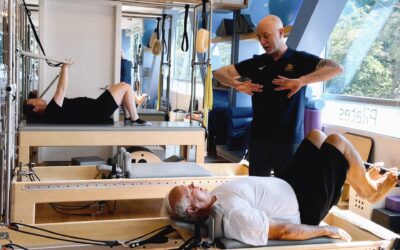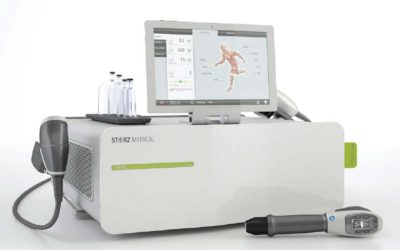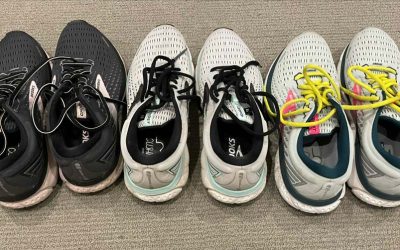Do you experience problems with low back or pelvic girdle pain that keep coming back no matter what you do? Or feel like you can’t get a deep breath into your ribcage no matter how much breathing practice you do?
Perhaps you’re a runner and keep getting stress fractures and tendon problems in the same leg whenever you increase your mileage, or you have hip problems such as groin pain, pinching, or tightness that doesn’t go away despite all your stretching and training…

Maybe you have mid-back pain that no amount of rolling, IMS/needling, mobility exercises or manipulation will take care of, or your concussion recovery has stalled and you feel frustrated with your plateau in progress..
Or you have pelvic floor problems such as incontinence or prolapse that aren’t changing despite kegel exercises or manual release. You may even notice increasing jittery-ness, anxiety, or temperature control & issues with excessive sweating – or restless sleep – that you never experienced before and perhaps started after an injury or accident…
While these are all very different symptoms, the common theme is that any of these problems could be caused by dysfunction movement patterns in your thoracic spine and ribcage – and the Thoracic Ring Approach™ could be the game changer for you.
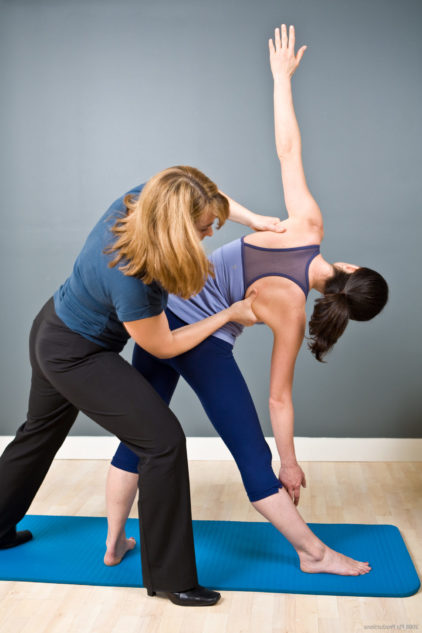
What is the Thoracic Ring Approach?
The Thoracic Ring Approach is the innovative, 3-D assessment & treatment model for the thoracic spine and ribcage created by Synergy Physiotherapist & Owner, Dr. Linda-Joy (LJ) Lee. LJ teaches this approach to physiotherapists around the world as post-graduate training through her education company, Dr. Linda-Joy Lee International | Institute for Physiotherapy & Movement.
After completing her advanced manual therapy training in 1999 (FCAMPT), LJ recognized early in her career that there was a significant gap in the understanding of this important region of the body. In trying to recover from her own injuries, she found there was only temporary and minimal relief from traditional approaches, and very few effective exercise approaches to train optimal function of the thorax. At the same time, she was finding that her patients needed something more – and thus began an almost 2 decade journey into questioning current paradigms, researching her clinical ideas, and creating a broader, functional framework that looks at the role of the thorax in the whole body and recognizes the importance of exercise and training muscle balance, as well as training the brain.
So what’s different about the Thoracic Ring Approach and how could it help you?
The thoracic spine & ribs should be assessed and treated as a 3-D “Thoracic Ring”
Traditional manual therapy approaches assess and treat the thoracic spine separately from the ribs, and focus on the back of the ring instead of the entire 3-D thoracic ring.
Anatomically & functionally, there are strong connections between the thoracic vertebrae and discs and the ribs, and the ribs have attachments via cartilage to your sternum anteriorly – this forms a “thoracic ring”.
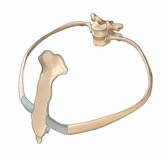
LJ is the original creator of specific ways to assess and treat the thoracic ring in a very functional way – through movements and activities that are meaningful to you. She first taught thoracic ring techniques as early as 2002, and since that time has evolved the Thoracic Ring Approach in many ways.
At Synergy Physio + Pilates, our therapists use the most up-to-date and current thoracic ring techniques and exercises as LJ keeps her team current on new developments in her models. Thus, we have a level of expertise in the Thoracic Ring Approach that you won’t find elsewhere – it is one of the things that makes us unique.
You may not have pain in your thorax but if it is not functioning optimally, it can be the underlying reason for pain or problems elsewhere in the body
The thorax is a key area for transferring loads through the body – it makes up to 20% of whole body length and up to 35% of your body’s mass. Consider how this affects weight-bearing and loading between your left and right legs. If you have imbalances in muscle control of your thorax, it can result in a translation of your thorax (and up to 1/3 of your body mass) to one side – left or right – and you will then habitually and repetitively end up loading one leg more than the other – this often explains why repetitive loading injuries like stress fractures happen on one limb more than the other, or why one quad is more developed than the other despite an equal training program.
Optimal function of your thorax allows you options for a variety of breathing patterns while you run, jump, twist and sing. The thorax is the centre for trunk rotation – any twisting or rotational movements depend on optimal muscle balance 3-dimensionally around the thorax. Have you been told you have a scoliosis? It may just be a double twist in your thoracic rings caused primarily by muscle imbalances. And the muscles of your “core” are attached to your thoracic rings and innervated from the thorax. This means that if your thorax is not functioning optimally, it can cause or “drive” problems with core muscle recruitment – from your abdominals and diaphragm to your pelvic floor.
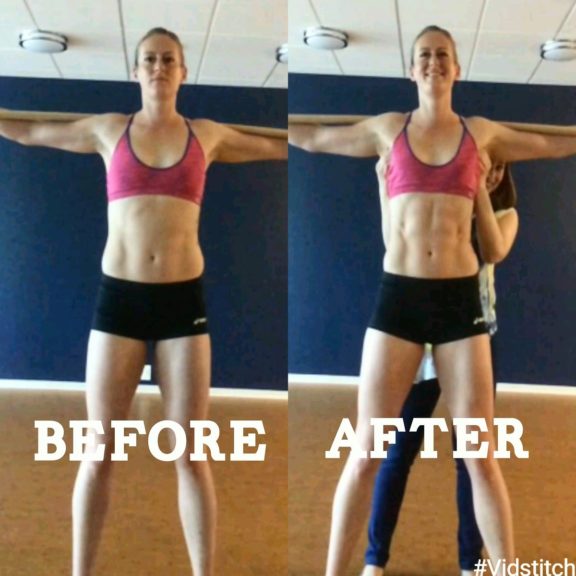
The impact of optimizing the upper thoracic rings on abdominal muscle recruitment – the only change between these photos is the manual support providing optimal control of the upper rings – there is no change in conscious muscle activity.
The diaphragm attaches to the lower 6 thoracic rings, and multiple thoracic ring muscles are involved in breathing – when these muscles are out of balance, they affect your options to breathe into different parts of your ribcage, which is sometimes more obvious during certain movements or activities because of the extra demands on the thoracic muscles to create movement and control.
As well, if your thoracic ring muscles are imbalanced, it can result in an imbalance between the pressure in your thoracic region (intra-thoracic pressure) and your abdomen (intra-abdominal pressure) – LJ made the clinical observation that patients with thoracic dysfunction often have a “pressure belly” or increased pressure on their pelvic floor – which then loads the tissues of the abdominal wall and/or pelvic floor, contributing to problems such as hernias, rectus diastasis, and pelvic floor pain and prolapse.
From a neurological perspective, your thorax is a key region that houses your Sympathetic Nervous System (SNS) – which governs your “fight or flight” response. If your thorax is not functioning optimally, your nervous system may be getting “mixed signals” about the status of your body and environment, and therefore respond with increased SNS activity – and stay in a “fight or flight” state – when it is not needed. We see many patients with agitation, anxiety, sleep disturbances, hyper-hidrosis and other signs of over-activity in the sympathetic system experience significant changes when we address and treat the cause of their thoracic dysfunction and change the input to the nervous system.
All this means that if you have less than optimal function of your thorax, even without thoracic pain, it can impact other parts of your body in ways that you may not expect.
Training Muscle Control, Balance, Strength and Endurance of the Thoracic Muscles is the Key to a Flexible Thorax
Does your thorax feel stiff? Do you feel tight when you twist your trunk? Do you feel like you are heavy and get jarring in your low back when you run?
As part of her PhD, LJ performed an extensive review of the research and showed that the common belief that the thoracic spine is stiff and needs to be mobilized, is completely inaccurate and untrue.
The structures of your thorax are actually designed to be extremely flexible and provide you with large ranges of motion for rotation/ twisting and bending sideways. Check out a golfer’s swing and you’ll see the role of the thoracic rings in trunk rotation. Across health professions, for many years, the common view has been that treatment of the thorax should be focused around mobilizing, manipulating, and releasing it. In contrast, LJ’s clinical and research work has shown the important role of training your neuromuscular control and working on balancing the forces from the muscle system.
Feeling stiff and heavy are signs that your thorax has lost it’s “spring” function, and the reason is most commonly that you have adopted non-optimal muscle patterns to control your thoracic rings, shoulder girdle and “core” – and these muscle patterns are causing compression and loss of movement options in your thoracic rings. The feeling of stiffness is because of over-active muscles that are not letting go for you to get range of motion.
You have 10 “stacking” thoracic rings that are like a spring or “slinky”, and when you have optimal muscle balance around your rings, you maintain space, have good shock-absorption throughout your back and lower body, and can create effective power when landing and jumping in explosive movements.

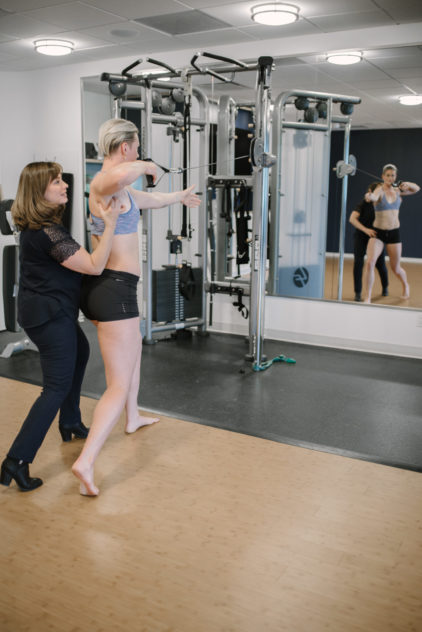
Traditionally, the treatment for “stiffness” in the thorax has been to try and stretch, release, roll and manipulate the thoracic spine… but without re-training your movement patterns and creating muscle balance around your Thoracic Rings, you will likely only get temporary relief from these types of treatments. LJ’s research supports that the key to feeling mobile and fluid in our trunk is to train different muscle patterns – and in the Thoracic Ring Approach we have a progressive and innovative way of prescribing exercises to balance your 3-D ring function.
A unique aspect of the way we train new movement patterns to change how you load through painful regions is by integrating specific hands-on thoracic ring releases while you train – this increases efficiency as it releases over-active muscles that are in your way, and simultaneously strengthens important muscles. Our aim is to train your nervous system and body so that you can use thoracic ring exercises as a way to “self-treat” your problem – a very powerful tool for you to manage your symptoms.
Training better movement patterns and optimizing muscle balance around your thorax can change your ease of movement throughout your whole body.
Not Everyone Needs Treatment to their Thoracic Rings
It’s important to note that you may experience the effects of dysfunction in your thorax, but this may not be the underlying cause, or “Driver”, of your problem. An important aspect of the Thoracic Ring Approach is that it enables us to first assess and determine if your thoracic dysfunction is the most relevant thing to treat. This means we don’t use a “trial and error” approach – we use a robust diagnostic called the Drivers Diagnostic Chart™ to determine if we should treat your thorax or not, at the outset of our process. This is also a key aspect of the ConnectTherapy model – a thorough assessment to determine where in your body is the “way in” to make the biggest change in your symptoms and your movement. You could have thoracic symptoms but your Driver could be your shoulder, and thus treating your shoulder will provide the greatest change in your symptoms.
Wondering if the Thoracic Ring Approach can help you? Want us to optimize your thoracic function by recommending changes to your current exercise program? Book an appointment today – all of our therapists can help.
Our Blog
Insights and Tips from Our Experts
Next Group Physio Healthy Bones™ Class starts Wed. Sept 13th – Sign up now!
Are you interested in improving your balance, stability, muscle strength and bone health? Then this class is for...
Shockwave Therapy – What is it & How can it help?
Shockwave therapy has become increasingly common as a treatment option for musculoskeletal conditions to assist...
Running and Pregnancy
Running has become a very popular sport, and more than half of recreational runners are women. For runners who...

